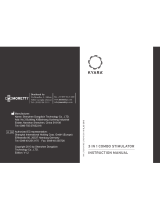
6
page
CONTRAINDICATIONS
• Cancer - absolute contraindication: wait until the end of the remission period for metastasis or circulatory cancer (leukemia).
- local contraindication: wait until the end of the remission period for other types of cancer, under interdisciplinary supervision.
•
Cardiac pacemaker: absolute or local contraindication, to be used under interdisciplinary supervision with permission from the attending cardiologist.
LOCAL CONTRAINDICATIONS
DO NOT APPLY TO THESE REGIONS
• Transcranial application: the risks of applying the electrodes in a transcranial application are unknown.
• Anterior neck region, carotid sinus (throat): risk of stimulating the vagus or phrenic nerves, pharyngeal muscles, or carotid sinuses.
• Eyes: the risks of treating this part of the body are unknown.
• All types of infections: risk of spreading the infection.
• Skin impairment: psoriasis, eczema, etc.. Caution in the vicinity of open wounds or healing scars.
• Undiagnosed persistent pain.
LOCAL CONTRAINDICATIONS
USE UNDER MEDICAL OR INTERDISCIPLINARY SUPERVISION
• Transthoracic and anterior application of the cardiac region.
• Electronic implant: risk of interference with the implant’s function.
• Heart disease: risk that the heart will have difculty compensating for the high metabolic demand.
• Pregnancy: abdominal and lumbar region during pregnancy. The -TENS- may be used in the lumbar region during childbirth.
• Skin sensory disorder, loss of sensitivity: risk that the patient does not adequately feel the current, which increases
the risk of skin burns or irritation.
• Genital organs: requires training.
• DVT/active phlebitis/embolism: risk of thrombus displacement in the bloodstream.
• Hemorrhage: risk of increasing bleeding.
• Epilepsy: local contraindication to the head and neck (cervical region). Precaution for the trunk and limbs.
Electrical stimulation could trigger an epileptic seizure.
•
Tuberculosis: electrical stimulation in this area may spread the infection during the active phase.
• Pacemaker: absolute or local contraindication, to be used under interdisciplinary supervision
with authorization from the attending cardiologist.
























